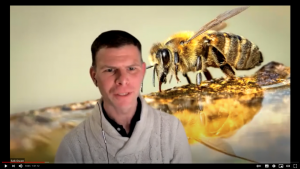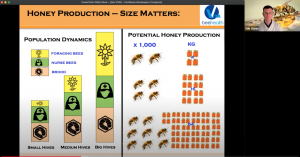Blog – bees, beekeeping & other sticky subjects
Changing of the guard
Graphs representing the changing population size of honey bee colonies often indicate a low point about now for bees living in these latitudes of Britain. The graphs are invariably very smooth — but is that really the case? Is the population change really so gradual?
The colony that has overwintered in the observation hive numbered about 2,500-3,000 bees until recently. The death rate, as indicated by the work of the undertaker bees, seemed very low. Very few dead bees were to be seen at the foot of the frame awaiting their exit.
Last week the weather was so cold that no bees could venture out but yesterday temperatures reached 10C. Flying time!
Lots took advantage of the better weather but this morning the population is noticeably smaller. Many — perhaps a few hundred — must have died on the wing. The left and right sides of the brood frame, which were quite well covered yesterday, are rather more sparse this morning.
Low and right of centre, the much tighter cluster (that has been there since the beginning of the month) shows where the queen began her season’s laying. She had been off-lay since last autumn but is now preparing her colony for the season ahead.
Looking for a Zoom speaker?
 Vita Bee Health is working as much as ever during the lockdown despite the pandemic travel restrictions. And you can still have a Vita speaker present to your group – via Zoom of course, and free of charge.
Vita Bee Health is working as much as ever during the lockdown despite the pandemic travel restrictions. And you can still have a Vita speaker present to your group – via Zoom of course, and free of charge.
Sebastian Owen of Vita has been giving very well-received talks recently – even in the Caribbean, virtually of course.
On 11 February he will present to the Bee Squad at the University of Maryland – at 7pm EST (midnight GMT). You can register for that one here.
But if you would like a talk at a time more suitable to your country, email to make your request. A very popular talk at the moment is: Nutrition – it isn’t all about the sugar, honey.
Vita at the virtual 2020 National Honey Show
Drone congregation areas revisited – podcast
Vita’s blogger has had a long time interest in drone congregation areas (DCAs) and has reported some of his thoughts and findings on this blog.
A new podcast series, Living Beeing, asked to interview with him, so he invited them along to Selborne Common, in Hampshire, England, to the location of the first documented evidence of a DCA by the Rev Gilbert White, the pioneering 18th century naturalist.
It was a perfect afternoon, just one day before the 300th anniversary of the Rev White’s birth. Perhaps the drones realised that and put on a stunning performance — even before a queen pheromone lure was hoisted — buzzing loudly at the same spot that White had reported his mysterious finding in 1792, in the last year of his life. He never knew what the sound was — but we do now.
The podcast is here.
And some videos of DCAs are here.
Pollen varies in quality
Here’s a selection of pollens gathered by bees in southern England in May 2020.

The yellow is oilseed rape (canola).
Brick red is horse chestnut.
Blue is phacelia (grown for game birds).
That’s quite a selection, but all pollen isn’t of the same quality. And it does deteriorate over time.
But whatever the season there is sustenance for bees from Vita:




